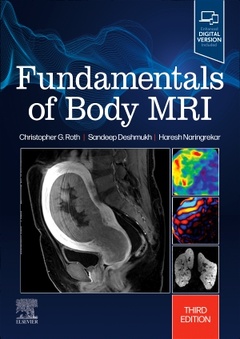Description
Fundamentals of Body MRI (3rd Ed.)
Fundamentals of Radiology Series
Authors: Roth Christopher G., Naringrekar Haresh, Deshmukh Sandeep
Language: English
Subjects for Fundamentals of Body MRI:
Keywords
Christopher G. Roth. Sandeep Deshmukh. Fundamentals of Body MRI. MRI. liver lesions. LI-RADS system. liver disease. gallbladder. biliary system. pancreas. spleen. kidneys. ureters. urinary bladder. Bosniak v2019. adrenal glands. retroperitoneum. gastrointestinal system. MR defecography. rectal cancer. MR enterography. bowel disease. uterus. cervix. vagina. ovaries. adnexa. O-RADS scheme. ovarian lesions. PI-RADS system. prostate
122.45 €
Not Yet Published
Add to cart520 p. · 18.4x26 cm · Paperback
Description
/li>Contents
/li>Biography
/li>
Covers all common body MR imaging content, along with discussion of how physics, techniques, hardware, and artifacts affect results-all summarized in an easy-to-read format with practical applications throughout.
Features more than 1,600 detailed MRI images and 100 algorithms and diagrams that highlight key findings and help you grasp visual nuances of images you’re likely to encounter.
Contains extensively revised content on liver lesions, including new coverage on LI-RADS system, and new safety tips and guidelines that keep you up to date.
Includes new information on MR defecography and advances in rectal cancer staging and post-treatment imaging, including new content on inflammatory bowel disease.
An eBook version is included with purchase. The eBook allows you to access all of the text, figures and references, with the ability to search, customize your content, make notes and highlights, and have content read aloud. Any additional digital ancillary content may publish up to 6 weeks following the publication date.
1. Introduction and Physics of Body MRI
I think a section on MRI safety would be useful here; it's a substantial topic, but I think it can be distilled down to a fairly short discussion. Interested readers should be referred to sources for a more in-depth treatment of this topic. Existing figures will be reviewed and updated as necessary.
2. MRI of Focal Liver Lesions
The main update to this chapter will be to introduce new LI-RADS system. Existing figures will be reviewed and updated as necessary.
3. MRI of Diffuse Liver Disease
This chapter was substantially updated in the 2nd edition and should not require much except for updated figures as necessary.
4. MRI of the Gallbladder and Biliary System
Existing figures will be reviewed and updated as necessary; no major updates to this chapter are expected.
5. MRI of the Pancreas and Spleen
Existing figures will be reviewed and updated as necessary; no major updates to this chapter are expected.
6. MRI of the Kidneys, Ureters, and Urinary Bladder
The main update to this chapter will be the proposed Bosniak v2019 system that applies to MRI. Additional MRI lesion features, including our own work, will be added and figures will be reviewed and updated as necessary.
7. MRI of the Adrenal Glands and Retroperitoneum
Existing figures will be reviewed and updated as necessary; no major updates to this chapter are expected.
8. MRI of the Gastrointestinal System
The main updates to this chapter are to add MR defecography and the advances in rectal cancer staging and posttreatment imaging with greater standardization in reporting and the standardization in the approach to MR enterography and reporting inflammatory bowel disease.
9. MRI of the Uterus, Cervix, and Vagina
Existing figures will be reviewed and updated as necessary.
10. MRI of the Ovaries and Adnexa
The main update to this chapter is the ongoing development of the O-RADS scheme for classifying ovarian lesions. Existing figures will be reviewed and updated as necessary.
11. MRI of the Prostate and Male Genitourinary System
The main update to this chapter is the updated PI-RADS system for classifying lesions on prostate MRI.
Associate Professor, Division Director, Body CT, Medical Director, Jefferson Outpatient Imaging-Collegeville; Chairman, Residency Selection Committee, Department of Radiology, Thomas Jefferson University, Philadelphia, Pennsylvania
These books may interest you

Diagnostic Imaging: Gastrointestinal 345.55 €



